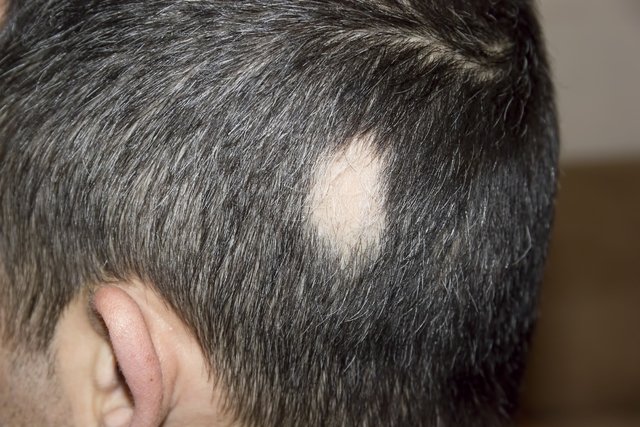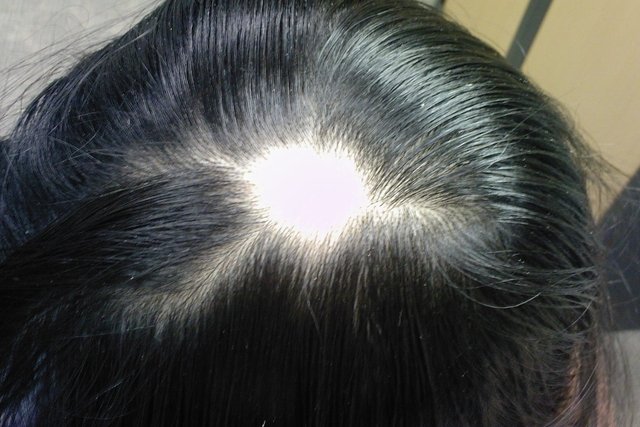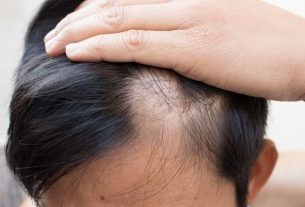Alopecia areata is a type of alopecia that affects hair follicles, leading to hair loss in other areas of the body, such as eyebrows, beard, legs and arms, and can be seen through symptoms such as circular hair loss and formation of whitish plaques at the site of hair loss.
The exact cause of alopecia areata is not yet completely known, but it is believed to have an autoimmune origin, in which the immune system produces antibodies that attack the healthy cells of the hair follicles, and may also develop due to genetic factors.
The treatment of alopecia areata is carried out by a dermatologist, and varies according to the severity of the hair loss, and the application of ointments to the scalp or injections may be recommended, with the aim of stimulating hair growth.

Symptoms of alopecia areata
The main symptoms of alopecia areata are:
- Sudden hair loss on the scalp, beard, eyelashes, eyebrows, or any part of the body that has hair;
- Circular or oval-shaped hair loss;
- Single, round, smooth, shiny-looking whitish plaque, where hair loss occurred;
- Hair shaped like an “exclamation point” at the edges of the lesion;
- Broken or short hair in the affected area;
- Complete loss of scalp hair, called alopecia areata totalis;
- Loss of hair and hair all over the body, known as alopecia areata universal;
- Local itching or burning sensation, before hair or fur falls out, in some cases.
Despite the absence of hair in the affected area, the hair follicles are not destroyed and, therefore, it is possible for the situation to be reversed through appropriate treatment.
Furthermore, it is common that when the hair grows back in the region it is white or gray in color, but then returns to its normal color.
Some people may also experience changes in their nails, such as small depressions, or “dimples”, fissures, red spots and nail loss, for example
How to confirm the diagnosis
The diagnosis of alopecia areata is made by a dermatologist through the evaluation of symptoms, health history and physical examination, evaluating the scalp, beard, eyelashes, eyebrows and other areas of the body, such as legs or arms, where hair loss has occurred.
In addition, the doctor can perform a dermoscopy exam, with the aim of analyzing the affected region in more detail, and it may be possible to check the presence of premature hair growth, such as broken hairs, short hairs, exclamation point hairs, dots. black or yellow, for example. See how dermoscopy is performed.
In cases that are difficult to diagnose, the doctor may also request a skin biopsy, and rule out other conditions that may have similar symptoms, such as trichotillomania, traction alopecia, Tinea capitis or cutaneous aplasia, for example.
Which doctor to consult?
The doctor responsible for evaluating and diagnosing alopecia areata is the dermatologist, who, depending on the cause and severity of the symptoms, can recommend the most appropriate treatment.
Taking care of your health has never been easier!
Possible causes
The causes of alopecia areata are unknown, but it is believed to be a multifactorial situation that may be related to some factors, such as:
- Genetic factors;
- Autoimmune diseases, such as vitiligo and lupus;
- Stress;
- Anxiety;
- Thyroid changes.
It is important that the cause related to alopecia is identified, as this allows treatment to begin to resolve the cause, which can alleviate symptoms and promote hair growth.
How the treatment is carried out
The choice of treatment must be made together with the dermatologist according to the degree of alopecia and related cause, and the use of:
- Cortisone injections: They are applied once a month to the area where hair loss occurred. Along with the injections, the patient can also use creams or lotions to apply to the affected area at home;
- Topical minoxidil: liquid lotion that must be applied twice a day to the area with hair loss, but is not effective in cases of total hair loss;
- Antralina: sold in the form of a cream or ointment, it must be applied to the affected region, which may cause changes in skin color. The concentration to be purchased and the application time of this medicine must be done according to medical advice.
More serious cases of hair loss in various regions of the body can be treated with the use of corticosteroids and immunosuppressants, according to the doctor’s advice.
Does alopecia areata heal on its own?
It is possible that in some cases, alopecia areata will heal on its own, within 6 to 12 months after the start of hair loss. However, it may happen that the hair falls out again in the same affected area, or even worsens, affecting hair all over the body.
In any case, it is important to consult a dermatologist for an evaluation and diagnosis of alopecia areata, and if necessary, undergo treatment, as hair loss can cause psychological disorders and affect quality of life.
Read too: Is alopecia curable? 6 treatment options
share the information
Bibliography
- JUARÉZ-RENDÓN, KJ; et al. Alopecia Areata. Current situation and perspectives. Arch Argent Pediatr. 115. 6; e404-e411, 2017
- LEPE, K.; ZITO, PM IN: STATPEARLS (INTERNET). TREASURE ISLAND (FL): STATEPEARLS PUBLISHING. Alopecia Areata. 2022. Available at: <https://www.ncbi.nlm.nih.gov/books/NBK537000/>. Accessed on February 7, 2023
- PRATT, CH; et al. Alopecia areata. Nat Rev Dis Primers. 3. 17011, 2017
- BISELLI, Larissa M.; ARRUDA, Lara F.; MAZZA, Maisa F. Diffuse alopecia areata and the autoantigen theory associated with melanogenesis. Surg Cosmet Dermatol. Vol 10. 3 ed; 272-275, 2018
- BRAZILIAN SOCIETY OF DERMATOLOGY. Alopecia areata. Available at: <https://www.sbd.org.br/dermatologia/cabelo/doencas-e-problemas/alopecia-areata/22/>. Accessed on 7 Jul 2020
- CAVALCANTI, Carla P. Alopecia treatment protocols: a literature review. Course Completion Work, 2015. State University of Paraíba.

Sign up for our newsletter and stay up to date with exclusive news
that can transform your routine!
Warning: Undefined array key "title" in /home/storelat/public_html/wp-content/plugins/link-whisper-premium/templates/frontend/related-posts.php on line 12
Warning: Undefined array key "title_tag" in /home/storelat/public_html/wp-content/plugins/link-whisper-premium/templates/frontend/related-posts.php on line 13




